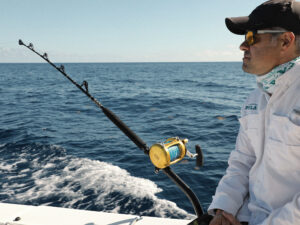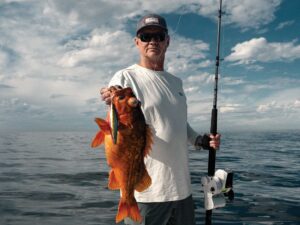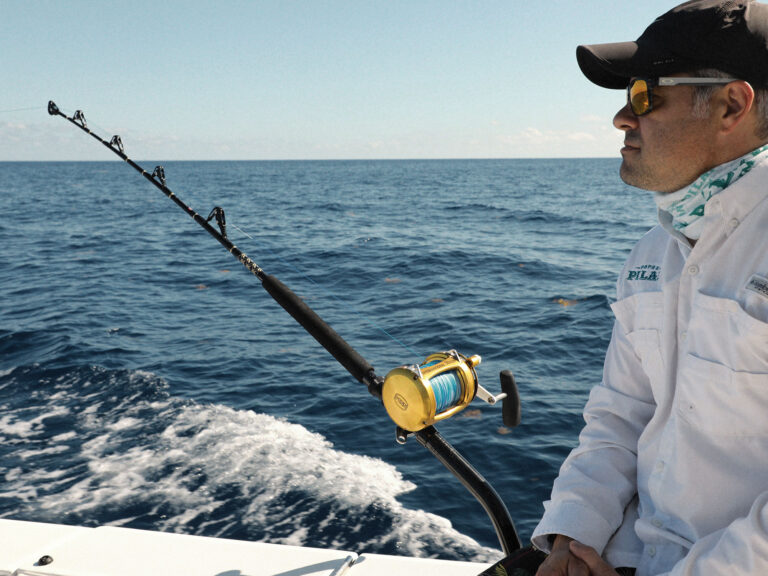
Many consider snapper the headliners of the myriad Bahamas reef species. Hit the right spots and the right conditions with the proper techniques, and plump yellowtails, muttons and mangroves are the rewards. Go deep, and you’ll add even more players to the roster.
Location, Location
Precise GPS coordinates to prime Bahamas bottom spots are so guarded, anglers commonly assign them code names.
After a successful day of bottomfishing some years ago, three gentlemen stopped me as I left my boat at the Bimini Big Game Club docks. One, a Bimini homeowner, had heard me mention “Wilson Rocks” on the radio. No such spot exists, he insisted, unfurling a chart. I pointed to nearby Piquet Rocks, and asked if he’d heard of Wilson Pickett. He nodded and slowly came to realize how the 1960s pop singer inspired my code name for the spot. Then he asked when was prime time to fish the spot. “The Midnight Hour,” I said and made my getaway.
Fortunately, quality bottomfishing spots are not hard to find in the Bahamas, where success mostly boils down to tactics and conditions.
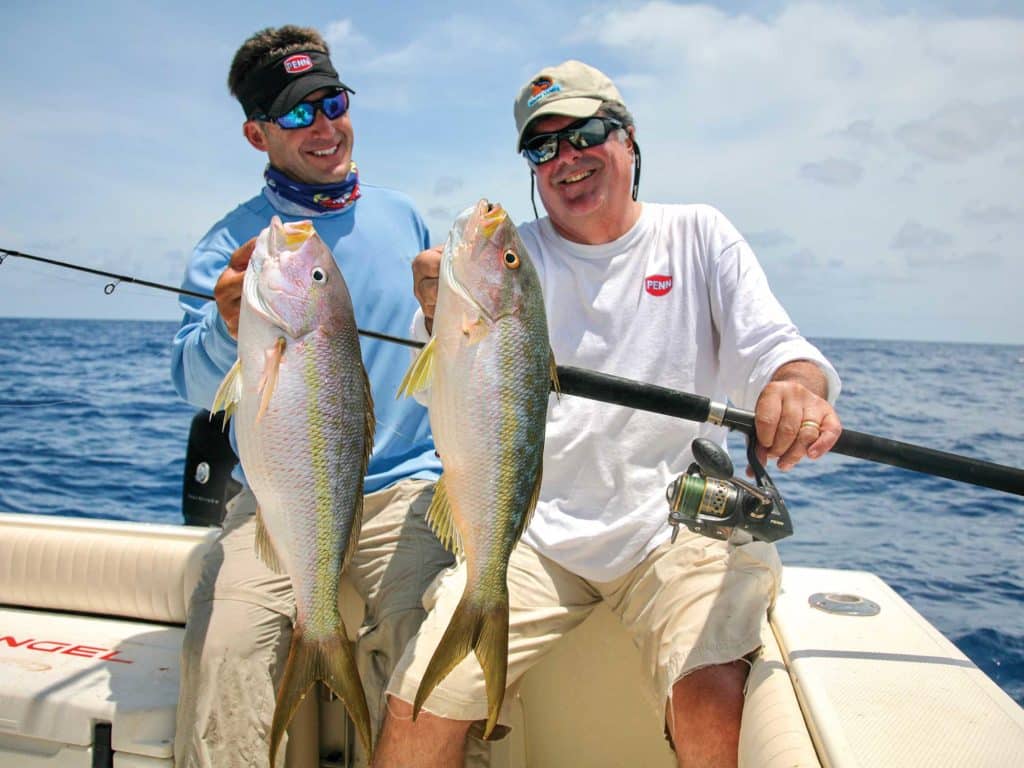
Yellow Gold
Yellowtails abound in the Bahamas year-round. Even heavily pressured Bimini and West End yield terrific action at times. Fish numbers and size increase proportionately the deeper one travels into the islands nation. Two summers ago, Harry Vernon III and I made the run from Miami to the Cape Eleuthera Resort and Marina, and nearby we uncovered a spot where the ’tails were big and so solid, they were eating out of the chum bag. Surprisingly, that spot seemed untouched on our most recent visit. Flag (large) yellowtails were still plentiful and ravenous.
In remote locations, a spinning outfit with 20-pound mono, a 1/16-ounce jig head, and a 1/0 circle hook or a No. 1 J hook tied directly to the line stops most big yellowtails from retreating to the reef, enabling anglers to horse them away from sharks. But more popular places, like Bimini, Chub Cay, Andros, West End and even the western Abacos, call for finesse fishing. You should fish 12-pound mono and tie the hook directly to it, or use 20- or 30-pound braid with a 20-foot top shot of 12- or 15-pound fluorocarbon. A silversides or a sliver of bonito, squid, conch or ballyhoo on a tiny jig or hook scores when free-lined to blend in with the chum.
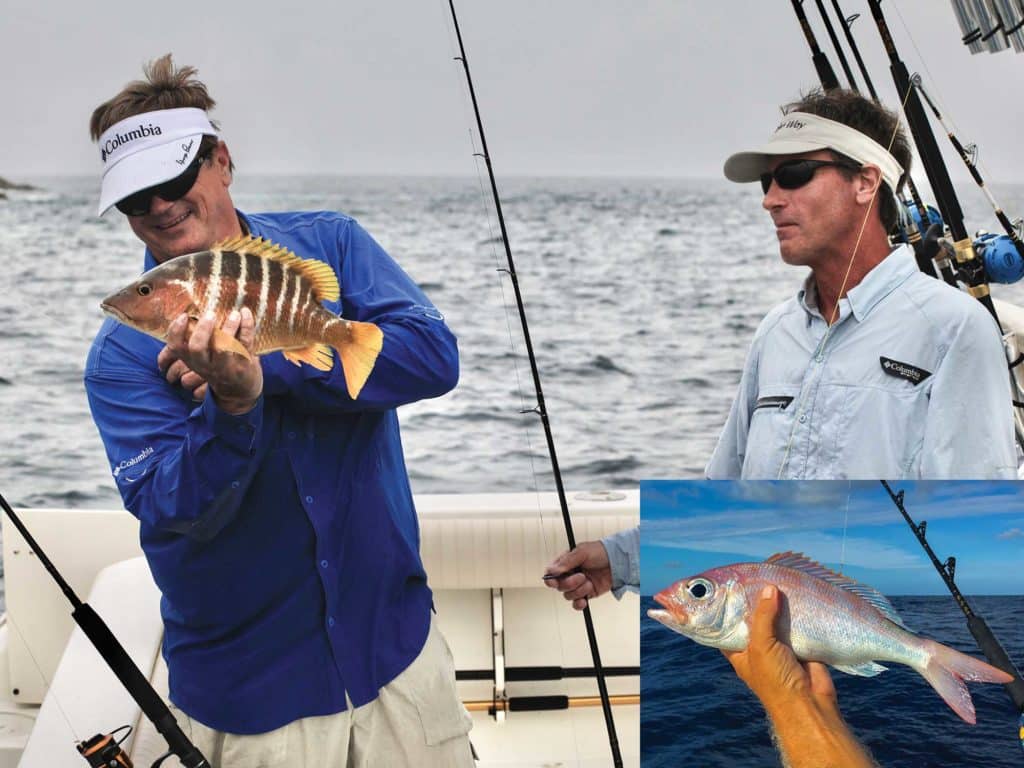
Chumming Tweaks
If yellowtailing where sharks are a nuisance, forgo ground chum and periodically disperse a handful of silversides. Once the ’tails warm up to the freebies, drift back a silversides impaled on a jig or hook. When you hook up, crank the fish in as fast as you can before sharks zero in.
The best yellowtailing exists on high-profile reefs between 60 and 80 feet. On points and bars jutting into deep water, like in the far-eastern and southernmost Bahamas, play the tides. Anchor where the chum will drift down over the edge, across the preferred depth range.
Anchor or Drift
Although anglers catch muttons while trolling swimming plugs along channels and cuts and slow-trolling ballyhoo across shallow coral reefs, bottomfishing and jigging are two extremely effective methods that involve anchoring and drifting.
For reefs and wrecks between 40 and 80 feet, anchor up-current of the sandy passages you’ll be fishing. Live pilchards, ballyhoo and goggle-eyes are prime offerings, as are whole dead and freshly cut sections of the same baits. When in season, fresh conch is a killer mutton bait.
Drifting for muttons is a game of edges. Focus on belts of sand winding through the reefs. Under a slow, manageable drift, drop a live pilchard, fresh squid, or butterflied ballyhoo or goggle-eye on a typical mutton rig (long leader). Keep the bait soaking in a potentially productive zone as long as possible, maintaining the reel in free-spool and using just enough thumb pressure to lift the sinker over high-profile structure. Then release that pressure to let the sinker hit bottom. Once the line scopes out at too great an angle to control, reel in, check the bait, and drop it back down. When the line speeds off, engage the drag and wind until the fish is hooked.
Small conventional outfits spooled with 30- or 50-pound braid are perfect for wrestling up muttons, and our go-to rig consists of 30 to 50 feet of 30- to 50-pound fluorocarbon (based on feeding aggressiveness), a 4/0 inline, extra-strong circle hook, and just enough weight to hold bottom. Strip off a few feet of line, engage the drag, and set the rod in a holder or stand at the ready. Once a mutton straightens out the long leader and the slack in the main line, the circle hook should set itself.
Run a circle hook through the anal vent of a pilchard, ballyhoo, goggle-eye or even a small grunt, piercing the bait’s side or belly with the hook point. The resistance from the sinker forces the tiring bait to swim upward, an enticing action for any lurking muttons. To prevent the hook point from turning back into the baits, bridle the larger ones, including the chunks.
Chum ’Em Up
Muttons prefer the outskirts of wrecks, sandy areas around reefs, and scattered patches with sea fans. Chum for them in 30 to 60 feet, and give them time to gather and rise to the chum. Then free-line baits on 2/0 to 4/0 inline circle hooks, 4-foot leaders of 30-pound fluoro, and 12- to 20-pound spin tackle.
A half-dollar-size chunk of bonito is a prime bait on a jig or knocker rig (a sliding sinker resting against the eye of a circle hook) if they’re holding deep. Various live baits, such as whole ballyhoo, squid or cut goggle-eyes, also work. Provided it’s in season, fresh conch purchased from local divers is a mutton crusher. Pin a meaty conch strip or chunk onto a circle hook and free-line it back, or fish a chunk on the bottom. To enhance the scent, add any conch slop to the chum bag and periodically broadcast small pieces into the slick.
Read Next: Bahamas Fishing Safari
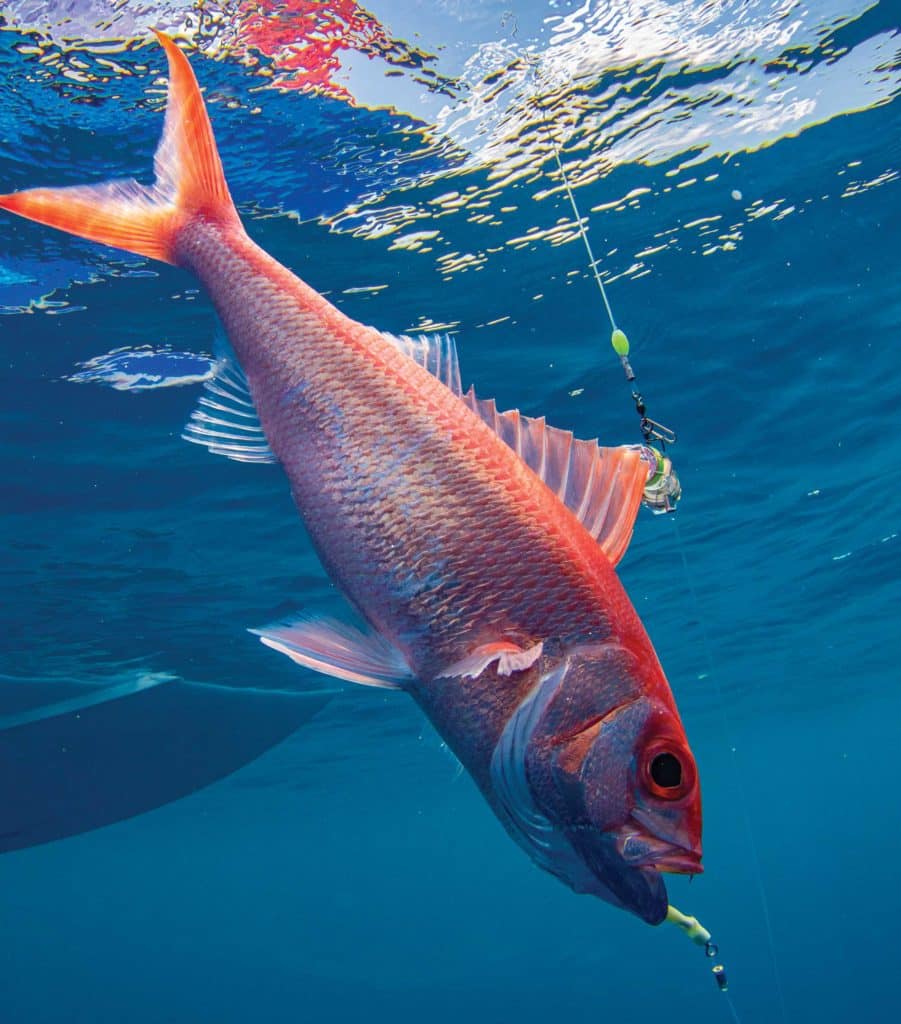
Deepwater Players
Deep-dropping is a different way to fish, but the rewards are every bit as tasty. Yelloweye and button snappers are the common players between 350 and 600 feet, with black snapper becoming more prominent farther south in the Bahamas. Out in 800- to 1,100-foot depths come silky and queen snappers, as well as mystic and snowy groupers.
While it’s increasingly common to use electric reels to deep-drop, I opt for hand-cranking for a more sporting approach using Penn Torque 15, 25N and 30-size lever-drag, two-speed reels with 30-pound braid. I tie a short Bimini on the end of the braid and attach it to a snap swivel, to which I affix a small LED deep-drop light and a 6-foot length of 80-pound mono leader with four 3/0 circle-hook leads (spaced so the hooks won’t tangle). I add a second snap swivel at the bottom of the rig to hold the weight.
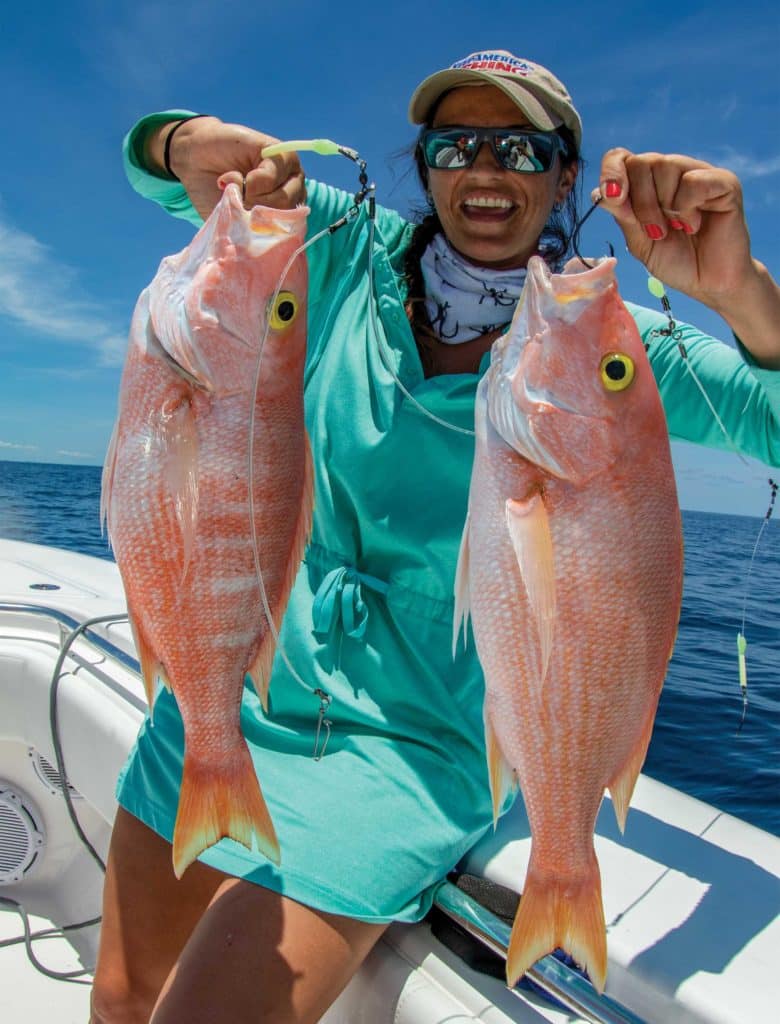
After baiting with bonito chunks and squid, lower the rig to the bottom and stem the current. Don’t short-strike any taps. A hookup will pull the rod tip down; keep the remaining baits in play for a minute or so for a chance at multiple hookups, then wind steadily back to the surface. Much like when drifting for muttons, the current must be light and manageable for success.
Cameos and Extras
Though not prevalent, cubera snapper periodically wreak havoc on tackle intended for muttons and yellowtails. Smaller ones are occasionally landed, but the big brutes usually prove unstoppable. At the opposite end of the spectrum, mangroves and schoolmasters are fine table fare and fun to catch on 8- to 12-pound spin tackle. They’ll consume small live baits, as well as pieces of squid, conch, pilchard, ballyhoo, bonito and even frozen shrimp, around shallow wrecks and reefs, and in cuts. A variation on the knocker rig is the ticket. It requires sliding a small sinker up the fishing line, then adding 3 feet of 12- or 15-pound fluorocarbon using a swivel, which prevents the sinker from sliding all the way down to the hook at the end of the leader.
For Bahamas trip-planning information and requirements for entry, visit bahamas.com.

